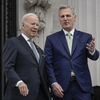Fitch cut the United States’ rating by one notch, moving it from the previous top-rated AAA to AA+, just two months after the government avoided a devastating default.
Win McNamee/Getty Images
hide caption
toggle caption
Win McNamee/Getty Images


Fitch cut the United States’ rating by one notch, moving it from the previous top-rated AAA to AA+, just two months after the government avoided a devastating default.
Win McNamee/Getty Images
Fitch Ratings cut the United States’ credit rating by one notch, from the top-rated AAA to AA+, saying rising deficits and political brinkmanship are imperiling the government’s ability to pay its debts.
The downgrade comes two months after the Biden administration and House Republicans agreed to suspend the government’s debt ceiling in a last minute deal, narrowly avoiding a potentially disastrous federal default.
It marks another rebuke for the U.S., which lost its AAA rating from Standard & Poor’s in 2011 in the midst of another debt ceiling standoff. Today, only one of the three major credit ratings agencies — Moody’s Investors Service — gives the United States a top-notch AAA rating.
Fitch acknowledged the strength of the U.S. economy and the advantages conveyed by the dollar’s role as the world’s most important currency.
But the credit rating agency warned of mounting red ink and an unwillingness in both political parties to grapple with long-term fiscal challenges, while expressing little confidence in the government’s ability to manage the country’s finances.
“In Fitch’s view, there has been a steady deterioration in standards of governance over the last 20 years, including on fiscal and debt matters,” the credit rating agency said in announcing the downgrade. “The repeated debt-limit political standoffs and last-minute resolutions have eroded confidence in fiscal management.”
Yellen issues a sharp rebuke
The move drew swift pushback from the Biden administration. Treasury Secretary Janet Yellen called it “arbitrary” and based on outdated information.
“Fitch’s decision does not change what Americans, investors, and people all around the world already know,” Yellen said in a statement. “Treasury securities remain the world’s preeminent safe and liquid asset, and…the American economy is fundamentally strong.”
Fitch notes the spending limits adopted as part of the debt deal clinched in June cover only a small fraction of the overall budget, and don’t address longer-term challenges in financing Social Security and Medicare for an aging population.


House Speaker Kevin McCarthy speaks to the media about debt ceiling negotiations as he arrives at the U.S. Capitol in Washington, D.C., on May 25, 2023. Fitch cited the debt ceiling standoff as another reason for its downgrade of the U.S. credit rating even after House Republicans and the Biden administration clinched a last minute deal.
Saul Loeb/AFP via Getty Images
hide caption
toggle caption
Saul Loeb/AFP via Getty Images


House Speaker Kevin McCarthy speaks to the media about debt ceiling negotiations as he arrives at the U.S. Capitol in Washington, D.C., on May 25, 2023. Fitch cited the debt ceiling standoff as another reason for its downgrade of the U.S. credit rating even after House Republicans and the Biden administration clinched a last minute deal.
Saul Loeb/AFP via Getty Images
Tax cuts and government spending have led to widening government deficits in recent years. And with rising interest rates, the cost of bridging that gap has increased. Government interest payments in the first nine months of the fiscal year totaled $652 billion — a 25% increase from the same period a year earlier.
“Today’s downgrade should be a wake-up call,” said Maya Macguineas, president of the Committee for a Responsible Federal Budget. “We are clearly on an unsustainable fiscal path. We need to do better.”
A loss to U.S. standing?
For almost a century, U.S. government bonds have been seen as some of the safest investments in the world — in large part because it seemed all-but-guaranteed the country would never miss a payment.
That reputation has made Treasurys popular with companies and countries around the world. But the country’s latest debt ceiling standoff have reinforced genuine concerns that the U.S could default for the first time.
S&P identified sharp political divisions as a key risk to the country’s ability to govern more than a decade ago, and many experts believe the divide has worsened since then.
This story originally appeared on NPR



